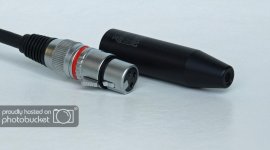There is also a lot of knowledge needed to interpretate/understand the measurements.
Its really important to learn how your measurement tools can lie to you. A tape measure that is off or a microphone that can roll off the top octave can lead you astray. Further with microphones and HF measurements you can get a lot of different results by moving the microphone a few cm one way or another in any axis.
I bought my Dayton Audio EMM-6 mic with calibration file from Cross Spectrum Labs a few years ago. It's still available. And I'm still happily using mine. It's just USD 75 for hobbyist purposes -- you don't need anything very fancy for your speaker measurements.
As per the calibration file, my mic has a large wide hump in its frequency response centred at around 10KHz. I am glad I have the calibration file and didn't just go ahead with the raw mic blindly.
As per the calibration file, my mic has a large wide hump in its frequency response centred at around 10KHz. I am glad I have the calibration file and didn't just go ahead with the raw mic blindly.
I use ARTA for SPL measurement now. I've used HolmImpulse sometimes. Used to use Speaker Workshop before 2016. All of them let me load the calibration file and then they correct the measurement accordingly.How do you apply...
Line Audio Design - Made in Sweden
$119 US. (plus currency conversion + shipping)

That's the interesting part. That's 2-2.5 mm's away from being a typical 1/2" capsule (..and significantly larger than a typical 1/4" capsule). And the resulting self-noise is decent for a 1/2" mic (..though often a good 1/2" mic actually has a bit lower self-noise.) Distortion at only .5% at 133db is also good for near-field measurements for non-linear distortion.
Moreover, they are using what appears to be a 1/4" opening to achieve that flatter response at high freq.s..
-I could see sending this to Cross-Spectrum for a better calibration file.
$119 US. (plus currency conversion + shipping)
Line audio..
..10 mm capsule is cho(sen) for lower self noise

That's the interesting part. That's 2-2.5 mm's away from being a typical 1/2" capsule (..and significantly larger than a typical 1/4" capsule). And the resulting self-noise is decent for a 1/2" mic (..though often a good 1/2" mic actually has a bit lower self-noise.) Distortion at only .5% at 133db is also good for near-field measurements for non-linear distortion.
Moreover, they are using what appears to be a 1/4" opening to achieve that flatter response at high freq.s..
-I could see sending this to Cross-Spectrum for a better calibration file.
Attachments
Last edited:
RE: Line Audio
The cavity in the front of the diaphragm will have a resonant peak. None of the measurements show anything beyond 20 KHz. A peak like that could be used to extend the HF response of a capsule that would be rolling off (B&K does this for free field microphones). However you do need to know what is happening out of band and off axis at high frequencies just to be sure of what to watch for. Its pretty reasonably priced but I would like to see comparisons to known standards to see consistency and response comparisons.
The cavity in the front of the diaphragm will have a resonant peak. None of the measurements show anything beyond 20 KHz. A peak like that could be used to extend the HF response of a capsule that would be rolling off (B&K does this for free field microphones). However you do need to know what is happening out of band and off axis at high frequencies just to be sure of what to watch for. Its pretty reasonably priced but I would like to see comparisons to known standards to see consistency and response comparisons.
- Status
- Not open for further replies.
- Home
- Design & Build
- Equipment & Tools
- Microphone for measurements
